Xtra knowledge about aeroplanes
Busy Busy Busy! It's the end of the semester, finished all classes, having a so called study break for a week (but i call it HOLIDAYS!), week after having final tests for a week, and then, i'm free for 5 weeks til Jan 15!!! yeay yeay!
Today's post is about aeroplanes, AGAIN. I guess some of you are dead bored of this by now, thousands of apologies! (kneals down and serve u chinese tea to apologise. Or u prefer teh tarik? ahhaha) Nah, it's not that i'm an aeroplane fanatic (a lil actually), but i just feel like sharing my knowledge with u guys. It's fun to know more about aeroplanes. It's huge, it's gigantic, it's heavy! but still, it flies... ain't that amazing?
Oh yea, before i proceed with the post, i would like to convey my condolences to the family of the demised new student who was involved in a road accident (he was on a bike) on wednesday night. And also, i hope the other guy who was involved in another different road accident on Monday(he was motorbike racing and paralysed waist down now) to get well soon, and I really hope a miracle will happen. To whoever who rides motorbike, PLEASE be a safe rider and make sure your bike is road-worthy. And for mat rempits, think twice before racing, is it worth using your flesh as your motorbike's protection? No.
Hey, bring the happy mood back! Let's learn more about aeroplanes! So, what do u know about aircraft's fuel and the storage tank(fuel tank)? It uses Diesel? Petrol? Liquid Hydrogen? It's stored in plastic bags under each seat? Circumfuring the fuselage(body)? Tail section? At the nose? No no no, the fuel tanks are here...

Fuel tanks
See the 3 red arrows? yea, that's where all the fuel are stored. The middle arrow is called the center belly tank, then the inboard wing tank, and the outboard wing tank. So, there are 5 fuel tanks in all with 2 on each wing, and the center tank having the biggest capacity. How big? I'm pretty sure u can play squash in there!
What type of fuel keeps the engine moving? For these big turbine powered engines, we use Kerosene. But we dun call it Kerosene in the industry, it's called Jet Fuel. There are 3 type of Jetfuels, namely Jet A, Jet A-1, and Jet B. These fuels are not colored blue or green or red like our Shell V-power or Unleaded'97 used by cars, but rather transparent of slightly yellowish (straw). Jet B fuel has a blend of kerosene and gasoline, whereas Jet A and Jet A-1 is pure kerosene.
Knowing that turbine powered aircrafts cruise at an amazingly high altitude of 30,000-40,000ft, the temperature up there must be freezing, not to forget the speed of aircraft of more than 900km/h! Though the freezing point of Jet A fuel is -40 degree celcius, yet ice can form and cause the engine to starve from fuel. Therefore, these fuels are added with inhibitors(some sort of chemical) to prevent fuel icing.
U might be wondering: "The most dangerous part of the plane must be the center, cos there's where all the fuel are" hahaha... Well, i guess so?! But hey, how often do planes crash? And till today, MAS' flights are pretty safe! hahaha... Dun be scared of flying! OUR LIVE IS FATED is my favourite sentence. That's what i told my parents when they disallowed me from applying for Cadet Pilot (they were worried that I might die in a plane crash).
Refuelling process is done most of the time when the aircraft lands, and normally it is refueled to FULL. Why? Just in case some emergency happens or the airport has heavy traffic and thus needs the aircraft to go for a few extra rounds, and that is when extra fuel is needed. So, it's a good practice to keep the tanks FULL, u dun wanna see the red warning light blinking in mid air rite?
The next time u board a plane, get the window seat slightly ahead of the wings, then u can view the refuelling process going on. You'll see a truck just underneath the wings with big pipings. And there will be this refuelling man walking down there (might be me! hahhaha!) opening up a cover on the floor, and connecting that big pipe into the ground at 1 end, following by the aircraft wing on the other end.
Today's post is about aeroplanes, AGAIN. I guess some of you are dead bored of this by now, thousands of apologies! (kneals down and serve u chinese tea to apologise. Or u prefer teh tarik? ahhaha) Nah, it's not that i'm an aeroplane fanatic (a lil actually), but i just feel like sharing my knowledge with u guys. It's fun to know more about aeroplanes. It's huge, it's gigantic, it's heavy! but still, it flies... ain't that amazing?
Oh yea, before i proceed with the post, i would like to convey my condolences to the family of the demised new student who was involved in a road accident (he was on a bike) on wednesday night. And also, i hope the other guy who was involved in another different road accident on Monday(he was motorbike racing and paralysed waist down now) to get well soon, and I really hope a miracle will happen. To whoever who rides motorbike, PLEASE be a safe rider and make sure your bike is road-worthy. And for mat rempits, think twice before racing, is it worth using your flesh as your motorbike's protection? No.
Hey, bring the happy mood back! Let's learn more about aeroplanes! So, what do u know about aircraft's fuel and the storage tank(fuel tank)? It uses Diesel? Petrol? Liquid Hydrogen? It's stored in plastic bags under each seat? Circumfuring the fuselage(body)? Tail section? At the nose? No no no, the fuel tanks are here...

Fuel tanks
See the 3 red arrows? yea, that's where all the fuel are stored. The middle arrow is called the center belly tank, then the inboard wing tank, and the outboard wing tank. So, there are 5 fuel tanks in all with 2 on each wing, and the center tank having the biggest capacity. How big? I'm pretty sure u can play squash in there!
What type of fuel keeps the engine moving? For these big turbine powered engines, we use Kerosene. But we dun call it Kerosene in the industry, it's called Jet Fuel. There are 3 type of Jetfuels, namely Jet A, Jet A-1, and Jet B. These fuels are not colored blue or green or red like our Shell V-power or Unleaded'97 used by cars, but rather transparent of slightly yellowish (straw). Jet B fuel has a blend of kerosene and gasoline, whereas Jet A and Jet A-1 is pure kerosene.
Knowing that turbine powered aircrafts cruise at an amazingly high altitude of 30,000-40,000ft, the temperature up there must be freezing, not to forget the speed of aircraft of more than 900km/h! Though the freezing point of Jet A fuel is -40 degree celcius, yet ice can form and cause the engine to starve from fuel. Therefore, these fuels are added with inhibitors(some sort of chemical) to prevent fuel icing.
U might be wondering: "The most dangerous part of the plane must be the center, cos there's where all the fuel are" hahaha... Well, i guess so?! But hey, how often do planes crash? And till today, MAS' flights are pretty safe! hahaha... Dun be scared of flying! OUR LIVE IS FATED is my favourite sentence. That's what i told my parents when they disallowed me from applying for Cadet Pilot (they were worried that I might die in a plane crash).
Refuelling process is done most of the time when the aircraft lands, and normally it is refueled to FULL. Why? Just in case some emergency happens or the airport has heavy traffic and thus needs the aircraft to go for a few extra rounds, and that is when extra fuel is needed. So, it's a good practice to keep the tanks FULL, u dun wanna see the red warning light blinking in mid air rite?
The next time u board a plane, get the window seat slightly ahead of the wings, then u can view the refuelling process going on. You'll see a truck just underneath the wings with big pipings. And there will be this refuelling man walking down there (might be me! hahhaha!) opening up a cover on the floor, and connecting that big pipe into the ground at 1 end, following by the aircraft wing on the other end.
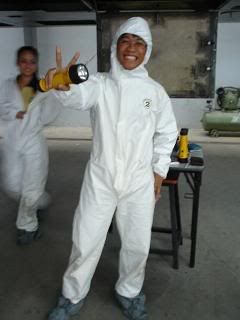
Wear this before entering the fuel tank for maintenance, cute leh?
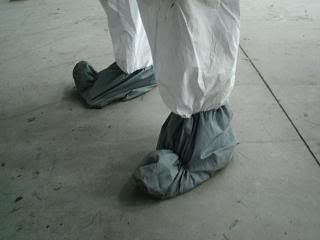
This is cuter!
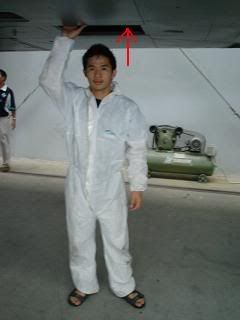
Albert - My mate, preparing to enter Boeing727 fuel tank
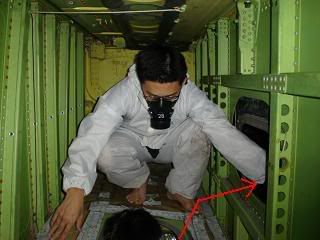
Did he notice that his flyer has burst?!
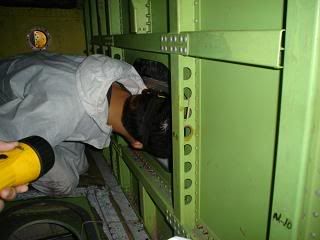
Believe me, people with more than 40in waistline, stay out!
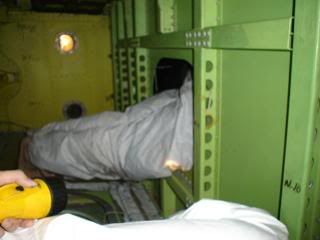
Now you see me, now you don't !
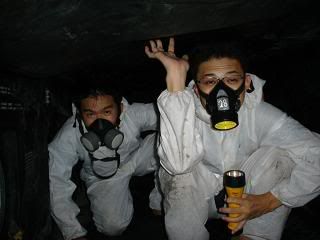
Dun forget to wear the respirator (fumes can cause impotency)
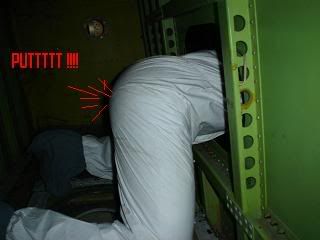
Now i know when the respirator comes to full use! ewww...
Enough of fueling. Now we'll talk about lightings. I'm sure it's easy to identify a plane flying during night time, having the blinking white, blue, and red lights standing out in the pitch black sky. Just like cars, aeroplanes have head lamps too! It's positioned at the inboard side of each wing. As for the tips of the wing, that's where the blinking lights will be. Left wing is for RED, and right is for blue/green. Therefore, if u see a plane in the sky, and the red light is on the RHS, blue is on the LHS, it means that the plane is coming towards you. If the plane is heading away from you, u won't see either of the red and blue lights, but rather a single white blinking light only. There are exceptions however, some manufacturers put so many lights on the plane, that it is almost impossible to fly into another plane without noticing it. That whole freaking thing in the sky is BLINKING!!!! hahaha...
Have a wonderful week ahead guys!
 Kampungkai is a name, and also a place in the virtual world where u read about his lovely writings. It's interesting, it's addictive. Do visit kampungkai during your free time and call out loud KAMPUNGKAI if u do see me!
Kampungkai is a name, and also a place in the virtual world where u read about his lovely writings. It's interesting, it's addictive. Do visit kampungkai during your free time and call out loud KAMPUNGKAI if u do see me!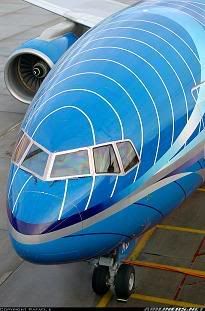

11 Comments:
You should climb into the fuel tank and light up a lighter, OK? Don't worry, I will visit you, some day. :D
Interesting part bout the lights. Didn't know that.
By Anonymous, at November 27, 2005 9:47 PM
Anonymous, at November 27, 2005 9:47 PM
MAS airlines might be safe but their staff mostly remained uninteresting and unfriendly. No point if the airline is safe while the staff is rude because it will scare off the passengers. Well, this remark is only noted to those travelling economy class, if you are having the First Class or Bussiness class level, you don't have to worry on this :)
By Swee Ping, at November 28, 2005 2:05 AM
Swee Ping, at November 28, 2005 2:05 AM
ahhh, how very educational..... oie, how come got some blokes in slipper and barefoot going aroung in a fuel tank? is this standard procedure?
cheers!
By JoeC, at November 28, 2005 7:37 PM
JoeC, at November 28, 2005 7:37 PM
jason: u watched too much cartoon!
sweeping: wowww...some1 must have stepped on your tail. i'm anti-MAS too!
joec: hahaha! u noticed that huh? SUPPOSEDLY standard procedures, but due to worn n torn equipments, forget it!
By Kampungkai, at November 28, 2005 9:31 PM
Kampungkai, at November 28, 2005 9:31 PM
haha..learnt a little today. we had to wear those kinda clothes to enter the LNG cargo tanks too..very the 'scientist'..
By yuin, at November 28, 2005 11:06 PM
yuin, at November 28, 2005 11:06 PM
The baju made of what one worr? So cepat koyak? Look quite plasticky to me.
By Gina, at December 11, 2005 8:03 PM
Gina, at December 11, 2005 8:03 PM
yuin: yea, very the scientist! haha... wonder why fashion designers dun make it winter 2005's fashion?
poison: yes it is cute. and yes it's pretty to hard to get in and out of the fuel tank. I had to put both hands straight up in order to get through, because my shoulders were broader than the hole!
gina: haha looks like plastic huh? nah, it's a kind of natural fabric, but i dunno what's the name of it. I love the shoes!
By Kampungkai, at December 18, 2005 12:35 PM
Kampungkai, at December 18, 2005 12:35 PM
the more I read your blog, the more I like it.
I love to watch Discovery and National geogrphic, especially when they talk about air bus (oh, the new bloody big air bus, I pregnant tht time they talk about how they build it, now they recieve order!), why, how the plane crash, extreme machine etc. So syiok! so envy you can work in one of this amazing machine.
you might wander why I like to know about how machine work, you know what kill the cat?
By Anonymous, at December 19, 2005 2:49 PM
Anonymous, at December 19, 2005 2:49 PM
longchamp outlet, replica watches, nike air max, oakley sunglasses, christian louboutin uk, ray ban sunglasses, nike free, longchamp pas cher, cheap oakley sunglasses, tiffany and co, jordan shoes, nike air max, christian louboutin, louboutin pas cher, ray ban sunglasses, prada handbags, oakley sunglasses wholesale, polo outlet, kate spade outlet, longchamp outlet, longchamp outlet, michael kors pas cher, prada outlet, gucci handbags, ugg boots, christian louboutin outlet, louis vuitton outlet, louis vuitton, chanel handbags, nike roshe, jordan pas cher, nike free run, air max, louis vuitton outlet, tory burch outlet, oakley sunglasses, oakley sunglasses, ray ban sunglasses, sac longchamp pas cher, louis vuitton, tiffany jewelry, nike outlet, christian louboutin shoes, polo ralph lauren, louis vuitton outlet, ugg boots, replica watches, uggs on sale
By oakleyses, at April 21, 2016 10:47 AM
oakleyses, at April 21, 2016 10:47 AM
iphone 6s cases, chi flat iron, ipad cases, north face outlet, hollister, ralph lauren, wedding dresses, nike air max, north face outlet, louboutin, baseball bats, insanity workout, iphone 6 plus cases, soccer jerseys, celine handbags, asics running shoes, ferragamo shoes, mcm handbags, valentino shoes, p90x workout, nike roshe run, babyliss, timberland boots, nfl jerseys, iphone cases, lululemon, iphone 5s cases, ghd hair, iphone 6 cases, mont blanc pens, longchamp uk, hollister clothing, beats by dre, reebok outlet, instyler, s6 case, oakley, bottega veneta, hermes belt, soccer shoes, herve leger, jimmy choo outlet, mac cosmetics, abercrombie and fitch, new balance shoes, nike trainers uk, iphone 6s plus cases, nike huaraches
By oakleyses, at April 21, 2016 10:52 AM
oakleyses, at April 21, 2016 10:52 AM
canada goose outlet, canada goose, swarovski crystal, canada goose, canada goose, karen millen uk, ray ban, coach outlet, wedding dresses, moncler, louis vuitton, moncler outlet, swarovski, moncler, ugg,ugg australia,ugg italia, juicy couture outlet, moncler, marc jacobs, barbour, gucci, ugg,uggs,uggs canada, toms shoes, links of london, supra shoes, pandora charms, doudoune moncler, hollister, canada goose outlet, ugg, converse, replica watches, pandora jewelry, pandora uk, ugg uk, barbour uk, moncler uk, moncler outlet, hollister, louis vuitton, louis vuitton, canada goose outlet, ugg pas cher, montre pas cher, louis vuitton, moncler, juicy couture outlet, louis vuitton, vans, canada goose uk, thomas sabo, canada goose jackets, nike air max, converse outlet
By oakleyses, at April 21, 2016 10:54 AM
oakleyses, at April 21, 2016 10:54 AM
Post a Comment
<< Home